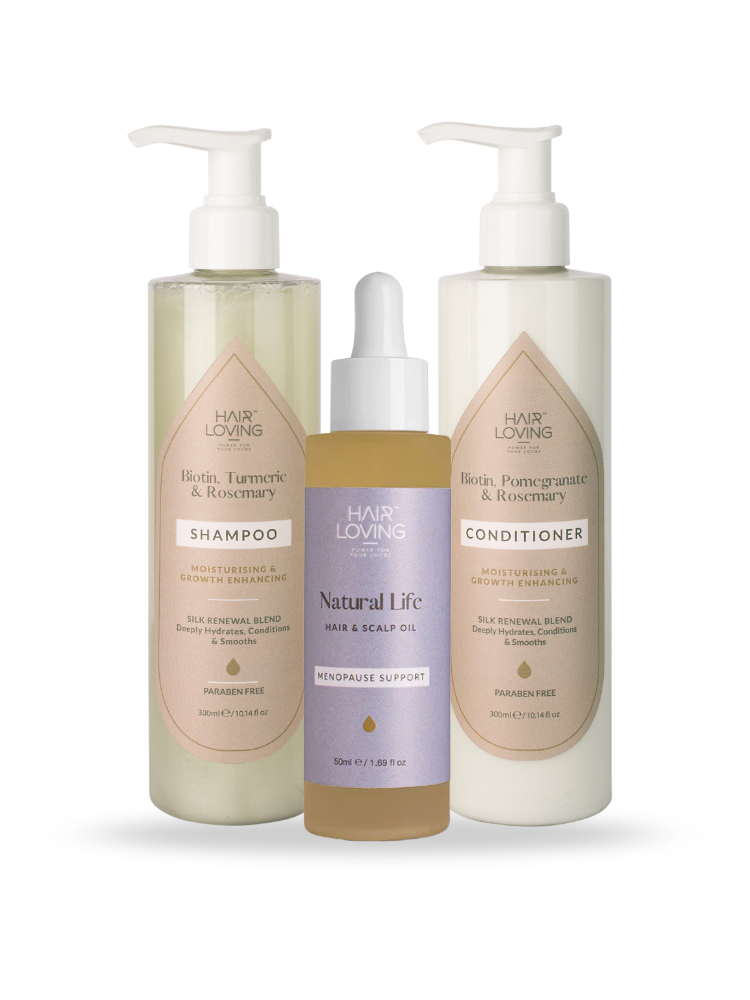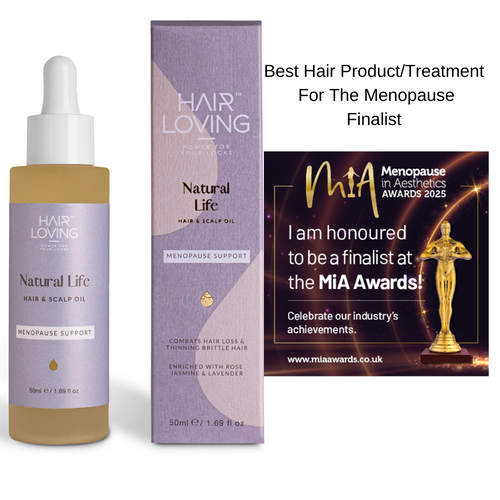This month, Hair Loving takes a look at how your hair is different during pregnancy and postpartum. We want to reassure all our mums-to-be or those of you out there who have recently given birth that these changes are common and totally normal, and offer a few tips on how to deal with them.
Hormonal imbalances before and after childbirth
The simple truth is that many pregnant women and new mothers notice differences in the texture and growth of their hair. That's because hormonal changes during pregnancy can both stimulate hair growth and reduce hair loss (which happens during pregnancy) and, later, result in some increase in hair loss in the months following childbirth or after women stop breastfeeding (postpartum).
Pregnant women in particular experience sudden and dramatic increases in estrogen and progesterone, whilst there will be a dramatic drop in progesterone after birth. This can affect the hair and cause a number of other physiological changes, such as the impact of exercise and physical activity on the body.
Estrogen and pregnancy
Let's begin with Estriol (E3) or Estrogen which is an important hormone in that it helps the fetus develop, mature, stay healthy, and prepares the body for childbirth and breastfeeding. Estrogen also regulates other key hormones and triggers the development of your baby’s organs. Under normal circumstances during pregnancy, each strand of your hair undergoes a three-stage cycle of growth, transition, and rest before eventually being pushed out by a new hair growing in the same follicle (the tube-shaped sheath beneath the skin which surrounds the hair).
However, while you're 'expecting', the extra estrogen you produce prolongs this growth phase, resulting in very little shedding of the normal 100 hairs that you lose daily. Thus around the fifteenth week of pregnancy, many women notice their hair becoming thicker: not because each hair strand has become more luxuriant, but because the hair stays in the growing phase of its cycle for longer, resulting in less hair falling out than usual. This is directly due to the increase in estrogen.
Progesterone and postpartum
Progesterone levels are also extraordinarily high during pregnancy, playing a significant role in expanding the uterus to a size that makes it capable of carrying a full-term baby while regulating your menstrual cycle. However, both progesterone and estrogen decrease as soon as your baby and placenta are delivered. It is not until the first menstrual cycle that the ovaries will begin to produce progesterone again, which will result in a short-term imbalance. Some women experience temporary hair loss (telogen effluvium) during this phase which sees the hair fall out in handfuls or new mothers may develop a few patchy areas of temporary baldness (excessive hair shedding). Again this is normal and not true hair loss.
From anywhere between three to nine months after giving birth, or even later if you're still breastfeeding, your hormones will settle down and your hair's growth cycle will return to normal, usually by the time your infant is around a year old. For some women, this change can seem dramatic but the condition is rarely permanent. Using New Beginnings Hair Oil on your hair during pregnancy and postpartum can help you minimise the harm caused by the fluctuations of your hormones, leaving you with healthy, lustrous hair again.
Regardless of the state of your hair, you should feel positive about these two hormones' functions and effects on your body during pregnancy and postpartum. They are both working towards creating the very best environment for your baby.
Hair Loving's Individual Oils
In addition to nourishing hair and reducing hair loss brought on by various hormonal changes, regular oiling is a fantastic way to unwind and relieve stress. You can commence this habit whenever you like but, if your aim is to lessen the potential damage to your hair from postpartum hormones, it's best to start using the oil while you're still pregnant. Remember, this effective botanical treatment works to restore your hair giving you conditioned, thicker, and healthier regrowth and it has been formulated with pregnant and new mothers in mind.
These luxury oils can also:
- help to prevent hair loss after giving birth by hydrating, nourishing, and strengthening your hormonal tresses
- penetrate the scalp and help to stimulate hair growth if you are experiencing patchy hair loss
- restore your hair to a healthier-looking state while increasing its volume and thickness
- increase the length and strength of your locks, giving them a more vibrant and youthful appearance.
How to use
- Comb hair through and apply 3 to 7 pumps (depending on hair thickness and length), massage into the scalp by dividing longer or thicker hair into up to 6 sections then gently spread oil from roots to tips.
- Once you have used the hair growth oil, shampoo and condition.
- Tip your head down letting your hair fall downwards.
- Place the widest part of a towel wrap against the base of the hairline on the neck and place all the hair into the wrap.
- Twist the wrap and button onto the loop.
- Leave for 5–15 minutes to absorb excess dampness.
- Style as normal.
Alternatively, apply the oil and leave on the hair using the towel wrap overnight, then wash and style as normal.
Multi-purpose oil: Apply as a sealing oil to wet hair or use on dry hair to tame frizz for beautifully conditioned hair. Style as normal. (This is not a heat-protecting product).
Use oil in conjunction with Hair Loving’s Anti-static Wide Tooth Detangling Comb to detangle wet or dry hair with minimal breakage and reduce hair loss and Luxury Hair Towel Wrap for added benefits.





